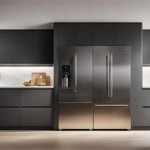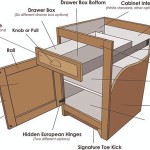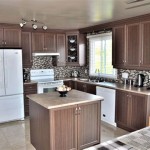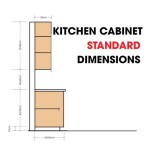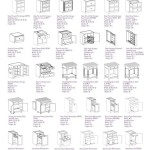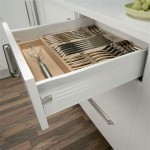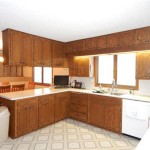Painting Oak Kitchen Cabinets Cream: A Comprehensive Guide
Oak kitchen cabinets, prized for their durability and distinct grain pattern, are a common feature in many homes. However, the natural golden or honey hue of oak can sometimes feel dated or clash with a desired aesthetic. Painting oak cabinets cream is a popular solution to brighten a kitchen while retaining the cabinets' structural integrity. This article provides a detailed guide to painting oak kitchen cabinets cream, covering preparation, painting techniques, and troubleshooting potential issues.
Understanding the Challenges of Painting Oak
Painting oak cabinets presents unique challenges compared to painting smoother wood surfaces. The open grain of oak wood creates a textured surface that can be difficult to cover evenly. The tannins present in oak wood can also bleed through paint layers, causing discoloration. Thorough preparation is crucial to achieve a smooth, durable, and aesthetically pleasing finish.
One of the primary challenges is the visible grain. While some homeowners appreciate the texture, others prefer a smoother, more modern look. Achieving a smooth finish on oak requires filling the grain with appropriate products before painting. Skipping this step will result in the grain being visible through the paint, regardless of the number of coats applied.
Another significant concern is tannin bleed-through. Oak contains tannins, which are natural compounds that can react with certain primers and paints, causing yellowish or brownish stains to appear on the painted surface. This is particularly common when using light-colored paints like cream. Using a high-quality stain-blocking primer is essential to prevent tannin bleed-through and ensure a uniform paint color.
Preparation: The Foundation of a Successful Paint Job
Proper preparation is the most critical aspect of painting oak kitchen cabinets. This process involves several steps designed to clean, degloss, and prime the cabinets to ensure proper paint adhesion and a professional-looking finish. A lack of thorough preparation can lead to peeling, chipping, and other issues that compromise the longevity and appearance of the paint job.
1. Removal and Labeling: Begin by removing all cabinet doors and drawers. Take off all hardware, including hinges, knobs, and pulls. Label each door and drawer with a corresponding number and location on the cabinet frame. This is crucial for easy reinstallation and prevents confusion later. A simple numbering system using painter's tape and a marker is sufficient.
2. Cleaning: Thoroughly clean all cabinet surfaces with a degreasing cleaner. Kitchen cabinets accumulate grease, food residue, and other contaminants that can interfere with paint adhesion. A mixture of warm water and dish soap, or a dedicated degreasing cleaner, can be used. Rinse all surfaces thoroughly with clean water and allow them to dry completely.
3. Sanding: Sanding is essential for creating a smooth surface and promoting paint adhesion. Use a medium-grit sandpaper (around 120-grit) to lightly sand all surfaces. Focus on removing any existing sheen and creating a slightly roughened surface. Be careful not to sand too aggressively, as this can damage the wood. After sanding, wipe down the cabinets with a tack cloth to remove all sanding dust.
4. Grain Filling (Optional): If a smooth, grain-free finish is desired, apply a grain filler to the oak cabinets. Grain filler is a paste-like product that fills the open pores of the wood, creating a level surface for painting. Apply the grain filler according to the manufacturer's instructions, typically with a putty knife or scraper. Allow the filler to dry completely, then sand it smooth with a fine-grit sandpaper (around 220-grit) before priming.
5. Priming: Apply a high-quality stain-blocking primer to all cabinet surfaces. An oil-based or shellac-based primer is recommended for oak cabinets due to their superior stain-blocking properties. Apply the primer in thin, even coats using a brush, roller, or sprayer. Allow the primer to dry completely according to the manufacturer's instructions. After the primer is dry, lightly sand it with a fine-grit sandpaper (around 320-grit) to create a smooth surface for painting. Wipe down the cabinets with a tack cloth to remove all sanding dust.
Painting Techniques for a Flawless Cream Finish
The application of the cream paint requires careful attention to detail to achieve a smooth, even, and durable finish. Choosing the right paint, using appropriate application techniques, and allowing for proper drying time are all crucial factors.
1. Choosing the Right Paint: Select a high-quality paint specifically designed for cabinets and trim. Acrylic latex paints are a popular choice for their durability, ease of application, and low VOC content. Oil-based paints offer excellent leveling and durability but have a longer drying time and higher VOC content. Consider a paint with a satin or semi-gloss sheen for its ease of cleaning and resistance to moisture.
2. Application Methods: There are several methods for applying paint to kitchen cabinets, each with its own advantages and disadvantages. Brushing, rolling, and spraying are the most common techniques. Brushing is suitable for smaller areas and intricate details, but it can leave brushstrokes if not done carefully. Rolling is a faster method for covering larger surfaces, but it can create a stippled texture. Spraying provides the smoothest and most even finish, but it requires specialized equipment and proper ventilation.
3. Applying Multiple Coats: Apply at least two coats of cream paint to the cabinets, allowing each coat to dry completely according to the manufacturer's instructions. Lightly sand between coats with a fine-grit sandpaper (around 320-grit) to remove any imperfections and create a smooth surface for the next coat. Wipe down the cabinets with a tack cloth to remove all sanding dust before applying each coat of paint.
4. Drying Time: Allow the paint to dry completely before reassembling the cabinets. This may take several days, depending on the type of paint used and the humidity levels. Rushing the drying process can result in soft paint that is easily damaged. Ensure adequate ventilation to promote proper drying.
Troubleshooting Common Problems
Despite careful preparation and application, problems can sometimes arise during the painting process. Understanding these potential issues and knowing how to address them can save time and prevent frustration.
1. Brushstrokes or Roller Marks: Brushstrokes or roller marks can occur if the paint is too thick, the application technique is incorrect, or the paint is drying too quickly. To minimize brushstrokes, use a high-quality brush designed for smooth finishes and apply the paint in thin, even strokes. To minimize roller marks, use a smooth roller cover and avoid applying too much pressure. If brushstrokes or roller marks are visible, lightly sand the painted surface with a fine-grit sandpaper and apply another coat of paint using proper techniques.
2. Paint Peeling or Chipping: Paint peeling or chipping is often caused by inadequate preparation, such as insufficient cleaning, sanding, or priming. Ensure that the cabinets are thoroughly cleaned, sanded, and primed before painting. If paint is peeling or chipping, scrape off the loose paint, sand the area smooth, and re-prime and repaint.
3. Tannin Bleed-Through: Tannin bleed-through can occur if the primer is not effective at blocking the tannins in the oak wood. If tannin bleed-through occurs, apply an additional coat of stain-blocking primer to the affected areas. If the stain is severe, consider using a shellac-based primer, which is known for its excellent stain-blocking properties.
4. Uneven Coverage: Uneven coverage can occur if the paint is not applied evenly or if the primer is not properly tinted. Apply the paint in thin, even coats, ensuring that all areas are covered. If the primer is not tinted close to the final paint color, it may require more coats of paint to achieve full coverage. Consider tinting the primer to match the paint color to improve coverage and reduce the number of coats required.
5. Sagging or Running Paint: Sagging or running paint is caused by applying too much paint at once. Apply the paint in thin, even coats, allowing each coat to dry completely before applying the next. If sagging or running paint occurs, allow the paint to dry completely, then sand the area smooth and re-prime and repaint.

Diy Painted Oak Kitchen Cabinets Makeover

Diy Painted Oak Kitchen Cabinets Makeover

Bye Honey Oak Kitchen Cabinets O Brighter Painting

Diy Painted Oak Kitchen Cabinets Makeover

Bye Honey Oak Kitchen Cabinets O Brighter

How To Paint Pressed Wood Kitchen Cabinets Choice Cabinet

From To Great A Tale Of Painting Oak Cabinets

Restaining Kitchen Cabinets Cabinet Inspiration New Resurfacing

29 Beautiful Cream Kitchen Cabinets Design Ideas Antique White Hardwood Floors In

How To Paint Oak Cabinets And Hide The Grain Tutorial
Related Posts

